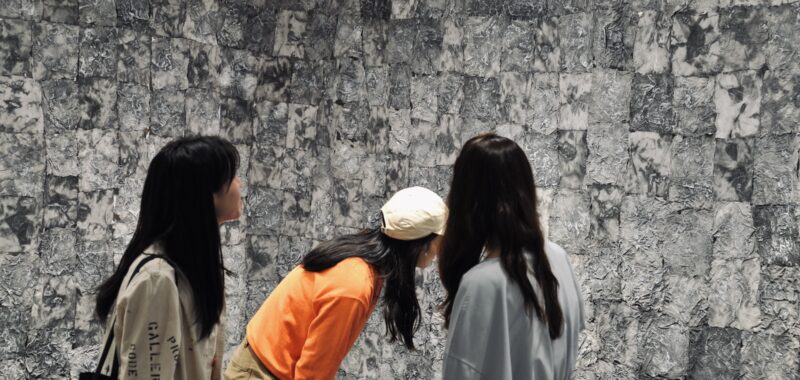When the pioneering artist-run feminist nonprofit A.I.R. Gallery launched a residency fellowship for emerging artists in the early 1990s, the first cohort consisted solely of one person, abstract photographer Tenesh Webber. Three decades later, the program’s cohort has expanded to six artists, who are currently exhibiting work at the gallery’s space in Dumbo, Brooklyn. Over the course of the fellowship’s history, more than 120 women and nonbinary artists have participated in this residency, receiving crucial resources and work opportunities at the beginning of their careers.
Now, the future of this longstanding fellowship lies in uncertainty in the wake of rescinded grant funding from the National Endowment for the Arts (NEA), an agency that, along with the National Endowment for the Humanities, President Donald Trump is seeking to dismantle.
Like scores of arts organizations around the country, A.I.R. received a notice from the federal agency earlier this month that its 2025 grant of $30,000 had been terminated due to a so-called misalignment of interests.

“The NEA is updating its grantmaking policy priorities to focus funding on projects that reflect the nation’s rich artistic heritage and creativity as prioritized by the President,” the email from the agency read, adding that future grants will be directed toward projects that “celebrate the 250th anniversary of American independence,” advance “AI competency” and “make America healthy again,” among a variety of other objectives that include “elevat[ing]” historically Black colleges and universities that serve Hispanic students.
The mass termination of grants has been decried by arts organizations around the country, including the national collective of U.S. Regional Arts Organizations. Notably, the notices were sent out just weeks after a puzzling federal court order that ultimately did not prevent the NEA from barring funds to arts organizations whose projects were deemed to promote “gender ideology.” (After being sued by four arts organizations, the agency said it had dropped the highly scrutinized funding requisite, although it has yet to remove the requirement from its website, where it is marked as “pending the outcome of litigation.”)
“It’s disheartening that NEA funding has been abruptly cut without prior notice, leaving A.I.R. scrambling to find alternative ways to support this vital program,” Brooklyn-based artist and current A.I.R fellow Stephanie Santana told Hyperallergic via email.
“I’m concerned about what these funding cuts will mean for artists across the country, and whose voices we’ll potentially miss out on if programs don’t continue,” she added.
“ This is not the first NEA award that we’ve lost. We lost our first grant in the late ’80s,” A.I.R’s Executive Director Christian Camacho-Light told Hyperallergic in a phone call. At the time, the NEA pulled grants from scores of individual artists and cultural organizations in response to pressures from conservative lawmakers and Christian extremist lobbyists that accused the agency of funding “obscene or indecent” art.
This isn’t the first time that A.I.R. has lost federal funding: In the late 1980s and ‘90s, the NEA pulled grants from the nonprofit alongside scores of individual artists and cultural organizations in response to pressures from conservative lawmakers and Christian extremist lobbyists that accused the agency of funding “obscene or indecent” art.
In the last few years, however, the NEA award has become a crucial resource for A.I.R’s fellowship program. Since 2021, the funding has accounted for approximately 20% of the program’s budget. It largely funds the solo exhibitions of the participating fellows, a key aspect of the program which also provides resources like curatorial support, professional development workshops, and mentorship opportunities. (The fellowship residency is also supported by funding from the city, the state, as well as a mix of individual donors and philanthropic foundations.)
The grant has also allowed A.I.R. to further develop the program in other ways, such as quadrupling stipends for fellows and adding more professional development opportunities for historically underrepresented artists, Camacho-Light said.

María de los Angeles Rodríguez Jiménez, one of A.I.R’s current fellows, described the guidance and support provided through the program as “invaluable.” Her solo show Hunter, Healer, Warrior, Death, which drew on Afro-Cuban oral histories and Yorùbá spiritual practices, ran for a month during March and April.
The nonprofit has submitted an appeal to the NEA to reconsider its decision, but Camacho-Light doesn’t expect that the agency will reverse its decision.
“ Our appeal letter points to the fact that in addition to A.I.R being a historically important and vital alternative art space and support system for women artists, women artists are inextricable from American art history from American stories,” Camacho-Light added.
A.I.R. has also reached out to the public for donations, and so far raised at least $5,000 of the $30,000 lost funding, Camacho-Light said. They emphasized that even in the absence of federal support, the nonprofit will not roll back on its support for women and nonbinary artists, including those in the current fellowship cohort and next year’s cohort.
“ A.I.R has lived through moments in which the gains of feminism and women and non-binary folks have faced headwinds, but it has always stuck to its mission,” Camacho-Light said, adding that there is still “rampant inequity” for women and nonbinary people in the arts and in broader society.
“There’s a need, and we’re going to continue meeting that need.”

